This was published 10 months ago
‘Away faster and home faster’: Inside the massive terminal at Sydney’s new airport
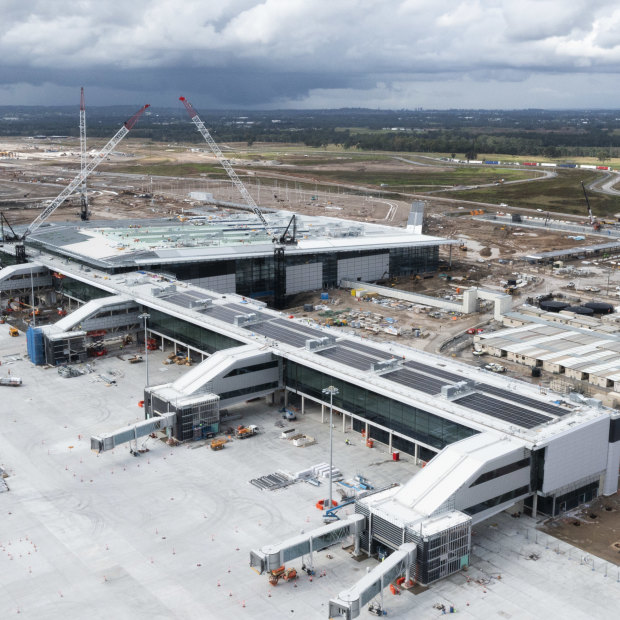
Western Sydney Airport’s terminal is quickly taking shape.Credit: Janie Barrett
Like giant claws stretching from a vast new terminal, the first of more than a dozen aerobridges have been installed at Sydney’s new international airport in the past few weeks.
In two years, passengers will begin filing off planes through the aerobridges and into the multistorey terminal, which has quickly risen from farmland flattened for Western Sydney Airport.
Standing on the tarmac, airport chief executive Simon Hickey points to the terminal’s design as critical to helping ease the “pain points” that passengers experience at airports such as at bag collection and check-in. “It’s always a bit fraught – any areas of processing. Some of that is in our control; some of it’s not if you are going through customs,” he says.
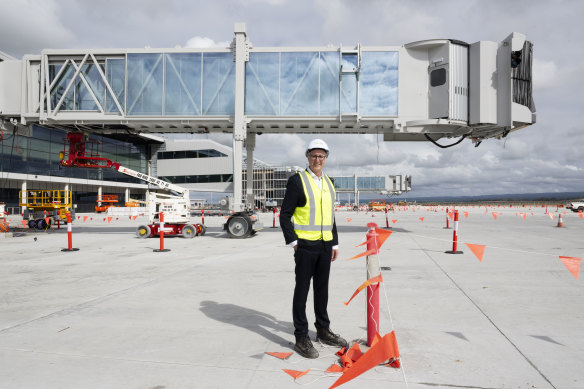
Western Sydney Airport chief executive Simon Hickey in front of one of the new aerobridges.Credit: Janie Barrett
Enormous windows and high ceilings are elements of the design, allowing light to stream into the terminal. Natural light will help guide passengers to and from gates and other parts of the terminal, as well as serving a psychological purpose in calming people.
Arguably, the stunning views of the Blue Mountains from terminal gates, airport lounges and large level-one concourse will be a drawcard. In the foreground, planes will land and take off on the 3.7-kilometre runway.
Hickey spruiks the airport’s “fast taxiways” as a key part of the design, which will make the average time for aircraft to taxi from the runway to the terminal gates about five minutes. “It gets you away faster and home faster, but it also means less fuel burn,” he says.
With the massive roof due to be completed by July, it is quickly starting to resemble an airport terminal inside. Near the ground floor entrance, holes in a large wall will become bag drop-offs, while kiosks servicing all airlines will be installed. Sandstone panels cover some walls, in a nod to the local area, while a vast timber ceiling is slowly being installed above.
Accessed through a nearby pedestrian link, an enormous room contains five baggage carousels each about 90 metres long. They are connected to the main part of the computer-driven luggage system in the basement below.
It will be different to the conveyor belt systems used at other Australian airports, using digital technology to track, load and shift bags to and from planes. Passengers will be able to track their bags using an app and know when they will turn up on a carousel after getting off a flight.
Lifts, escalators and stairs will provide access to the first level of the Multiplex-built terminal, where departing passengers will pass through security screening before walking into a massive concourse lined with shops and eateries. A mezzanine level has been built above, which will be used by international passengers and become the home for airline lounges.
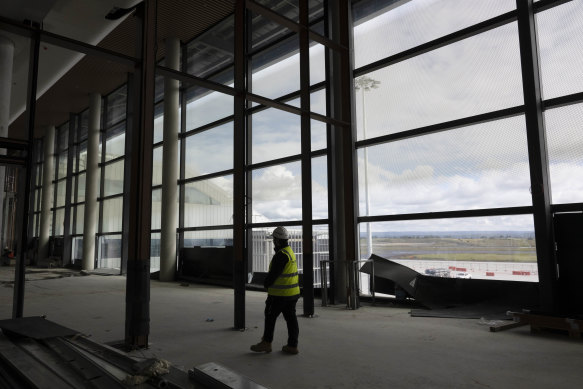
Passengers will have views of the Blue Mountains on their way to the terminal gates.Credit: Janie Barrett
An advantage of the new airport – formally named after pioneering Australian aviator Nancy Bird Walton – will be the ability for parts to be switched between serving domestic and international passengers. One of the five baggage carousels – referred to as a “swing carousel” – will be able to be switched from one to the other.
Importantly, the terminal will have three “swing gates” which will be able to accommodate both domestic and international aircraft. “That’s quite a significant thing,” Hickey says. “The ability to shift gates between international and domestic is a real advantage for us. We’ll have the fastest connect times on the east coast [between domestic and international].”
The 13 New Zealand-built aerobridges will be able to be automated, helping to avoid situations where planes packed with passengers have to wait at a gate for ground staff to operate them like at other airports.
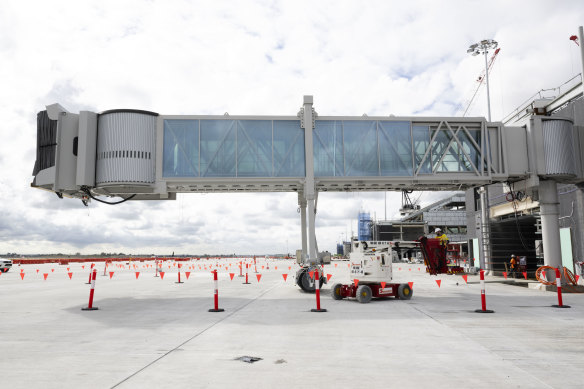
One of three New Zealand-built aerobridges installed in the past few weeks.Credit: Janie Barrett
In a sign of its time, the new airport will be Australia’s first without a traditional air traffic control tower. More than 20 high-resolution cameras will beam vision to air traffic controllers in a centre about 20 kilometres away at Eastern Creek. Infrared cameras will enable controllers to see more at night and during periods of low visibility. “They can see a chip packet that is moving across the runway,” Hickey says.
Testing and the integration of the airport’s 60 technology systems will ramp up from next year. Nine months of “full-on testing” will take place before the airport opens in late 2026. The testing will include turning on and off the lighting system and practising drills across the airport.
“It’s complicated because it’s an orchestra with lots of different people working on their parts,” Hickey explains.
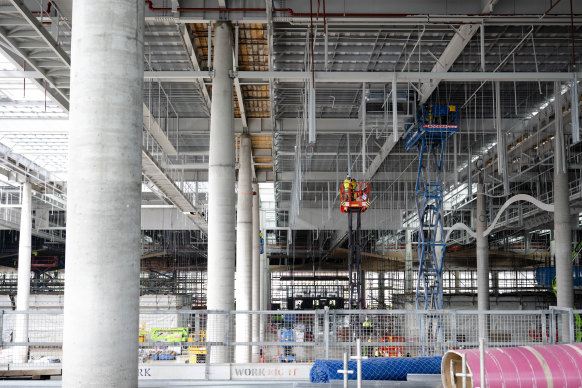
The main concourse on the terminal’s first level, which will have shops and eateries, is taking shape.Credit: Janie Barrett
“Since we’ve been building this we’ve had floods, we’ve had fires right on the fence line, we’ve had COVID and mice plagues and locust plagues. Yet here we are, and we’re still on time and on budget.”
Sydney University transport professor David Levinson cautions that the airport is a major but as yet unproven investment in western Sydney, saying that it may take decades to become successful. He cites the decades it took for Dulles Airport, about 42 kilometres from the centre of Washington DC, to gain significant use after it opened in 1962.
Hickey concedes there are airports that have failed such as Montreal’s Mirabel International, which was “built in the wrong place” and lacked transport links. But he quickly adds that the failures are well outnumbered by successes. “There are a handful you could point to that have fallen short of expectations for very specific reasons, and we have looked at those very carefully. But nearly all airports, other than those handful, and there are thousands, bring significant economic value and benefit,” he says.
With the opening in two years, Hickey, a former head of Qantas’ international operations, has been criss-crossing the globe trying to drum up interest among international airlines. He expects a mix of premium and budget airlines will end up flying to the curfew-free airport, which will have about 2.5 million people living within about an hour of its entrance.
“This is where all the action is. We will definitely have a great Asia-Pacific network. So as you can imagine, I have been talking to airlines around Asia-Pacific about that,” he says. “There is a lot of interest.”
When passengers start arriving in late 2026, it will also become the first airport in Australia to open with a rail link. An underground station on the metro line will be about 150 metres from the terminal’s entrance. It will be linked by a covered walkway for pedestrians, while another will lead to a car park that will have about 6000 spaces.
Built on a 1780-hectare site about 50 kilometres from Sydney’s CBD, the airport will be able to handle 10 million passengers a year when it opens, making it a similar size to Adelaide Airport. However, it has been designed to grow to 82 million passengers annually by the 2060s, which is comparable in size to Dubai and London’s Heathrow airports today.
Last year, Qantas and budget offshoot Jetstar committed to basing 15 domestic aircraft at the $5.3 billion airport within a year of its opening, which will fly to destinations such as Melbourne, Brisbane and the Gold Coast. The deal for five Qantas-branded aircraft and 10 Jetstar to be based there will result in about 4 million domestic passengers a year passing through the airport in the early years of operation.
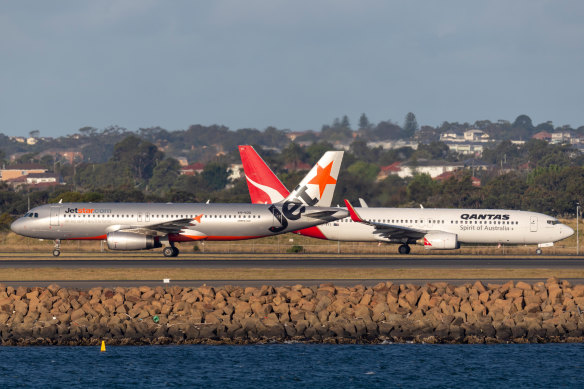
Five Qantas aircraft and 10 Jetstar planes will be based at Western Sydney Airport in its first year.Credit: Alamy
Hickey is eager to talk up the significance of the Qantas deal, while adding that the airport is “definitely talking” to Virgin Australia. Importantly, it will give international airlines which fly into the airport domestic connections for their passengers to other Australian cities.
Like rival Sydney Airport at Mascot, the new aviation hub in western Sydney will be designated a major airport under air rights agreements. It limits the ability of international airlines such as Qatar Airways flying to the new airport because they have reached the limit of flights they can make to Sydney under bilateral agreements with other countries.
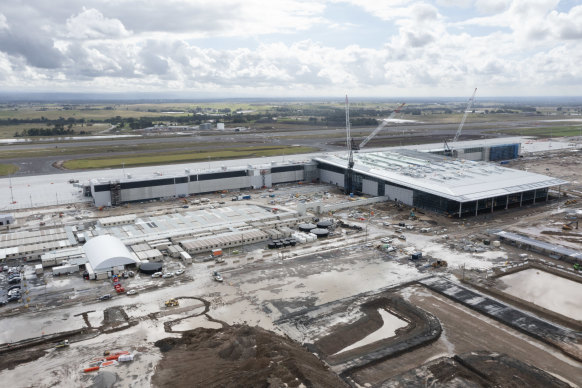
The terminal’s massive roof is due to be completed by July.Credit: Janie Barrett
Asked if he would like it to be designated a secondary airport, Hickey says it is “one of those question marks that still hangs over us”.
“It is ultimately a decision of government,” he says. “We’re focusing on some of those open-skies markets and some of the growth markets in Asia-Pacific.”
So-called open skies agreements with China, India, Singapore, New Zealand, the US and UK mean airlines from those countries will not face limits on flying to Sydney’s new airport when it opens.
With up to 4000 workers on site every day, the finish line for the country’s first major new airport since Melbourne’s Tullamarine opened in 1970 is in sight. “It’s the most significant piece of infrastructure in Sydney since the Harbour Bridge. This connects the west in a way that it hasn’t previously been connected, and it brings opportunities and jobs,” Hickey says.
Start the day with a summary of the day’s most important and interesting stories, analysis and insights. Sign up for our Morning Edition newsletter.